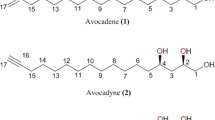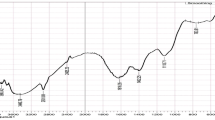Abstract
An ethanol extract ofAchillea millefolium L. showed repelling properties against the mosquito,Aedes aegypti L. Prepared fractions from the extract contained several active compounds which were characterized by thin layer chromatography, high performance liquid chromatography, gas chromatography and mass spectroscopy. Of 35 compounds tested, the most active were the nitrogen containing compound stachydrine, the carboxylic acids, caffeic, chlorogenic, and salicylic acids, and the phenolic compound pyrocatechol. These substances are earlier reported to occur inA. millefolium with the exception of pyrocatechol. Some further substances with lower activity were characterized for the first time inA. millefolium, i.e., adenine, ferulic and mandelic acid, and the methyl esters of capryliclinolenic- and undecylenic acid.
Zusammenfassung
Der Ethanolextrakt vonA. millefolium zeigte abwehrende Eigenschaften gegen die MückeAedes aegypti L. Die aus diesem Extrakt hergestellten Fraktionen enthielten mehrere aktive Verbindungen, die mittels Ditnnschichtchromatographie, Gaschromatographie und Massenspektrometrie charakterisiert wurden. Von den 35 untersuchten Substanzen waren die stickstoffhaltige Verbindung Stachydrin, die sauren Verbindungen Kaffee-, Chlorogen- und Salicylsäure sowie das Brenzcatechin die aktivsten. Diese Substanzen sind mit Ausnahme des Brenzcatechins schonfrüher aus A. millefolium beschrieben worden. Weiterhin wurden Adenin, Ferula- und Mandelsäure sowie die Methylestern der Capryl-, Linolen- und Undecylensäure als schwächer aktive Substanzen zum ersten Mal ausA. millefolium charakterisiert.
Similar content being viewed by others

Literature Cited
Andersson, I. H. 1991. Pages 21–23in Nectar feeding behaviour and the significance of sugar meals in mosquitoes (Diptera: Culcidae). Dissertation. Uppsala University, Sweden.
Bowen, M. F. 1991. The sensory physiology of hostseeking behavior in mosquitoes. Annual Review of Entomology 36:139–158.
Boyd, E. M., K. Bereczky, and J. Godi. 1962. The acute toxicity of tannic acid administered intragastrically. Canadian Medical Association Journal 92:1292–1297.
Chandler, R. F., S. N. Hooper, and M. J. Harvey. 1982. Ethnobotany and phytochemistry of yarrow,Achillea millefolium, Compositae. Economic Botany 36:203–223.
Charaux, C. 1910. Sur l’acide chlorogénique. Fréquence et recherche de cet acide dans les végétaux. Extraction de l’acide caféique et rendement en acide caféique de quelques plantes. Journal de Pharmacie et Chimie 7(2):292–298.
Christophers, S. R. 1960.Aedes aegypti (L.). University Press, Cambridge.
Dethier, V. G., L. B. Browne, and C. N. Smith. 1960. The designation of chemicals in terms of the responses they elicit from insects. Journal of Economic Entomology 53:134–136.
Ertiirk, E., J. F. Hatcher, T. Nunoya, A. M. Pamukcu, and G. T. Bryan. 1984. Hepatic tumours Sprague-Dawley (SD) and Fischer 344 (F) female rats chronically exposed to quercetin (Q) or its glycoside rutin (R). Proceedings of the American Association for Cancer Research 25:95.
Evans, P. D. 1980. Biogenic amines in the insect nervous system. Pages 317–473in M. J. Berridge, J. E. Trehorne, and V. B. Wigglesworth, eds., Advances in insect physiology 15. Academic Press, London-New York-Toronto-Sydney-San Francisco.
Fung, V. A., T. P. Cameron, T. J. Hughes, P. E. Kirby, and V. C. Dunkel. 1988. Mutagenic activity of some coffee flavor ingredients. Mutation Research 204:219–228.
Gans, O. 1929. Ueber die Dermatitis durchAchillea millefolium. Deutsche Medizinischer Wochenschrift 55:1213–1215.
Goh, C. L., and S. K. Ng. 1986. Contact allergy to salicylic acid. Contact Dermatitis 14:114.
Goldberg, A. S., E. C. Mueller, E. Eigen, and S. J. Desalva. 1969. Isolation of the anti-inflammatory principles fromAchillea millefolium (Compositae). Journal of Pharmaceutical Sciences 58:938–941.
Graf, E. 1992. Antioxidant potential of ferulic acid. Review article. Free Radical Biology and Medicine 13:435–448.
Harborne, J. B. 1984. Pages 42, 50, 57, 69-76, 84-89in Phytochemical methods. 2nd ed. Chapman and Hall, London and New York.
Hartung, R., and H. H. Cornish. 1968. Cholinesterase inhibition in the acute toxicity of alkyl-substituted 2-aminoethanols. Toxicology and Applied Pharmcology 12:486–494.
Hausen, B. M., J. Breuer, J. Weglewski, and G. Rücker. 1991. α-Peroxyachifolid and other new sensitizing sesquiterpene lactones from yarrow (Achillea millefolium L., Compositae). Contact Dermatitis 24:274–280.
Hegnauer, R. 1962–1986. Chemotaxonomie der Pflanzen. Vol. 1-7. Birkhäuser Verlag, Basel and Stuttgart.
Ivanov, C., and L. Yankov. 1971a. Composition ofAchillea millefolium. God. Vissh. Khimikotechnol. Inst., Sofia. 1967. 14:195–222. Through Chemical Abstracts 77:11147lp.
—, and—and. 1971b. Composition ofAchillea millefolium. God. Vissh. Khimikotechnol. Inst., Sofia. 1967. 14:223–241. Through Chemical Abstracts 77:111472q.
Jacobson, M. 1982. Plants, insects, and man. Their interrelationships. Economic Botany 36:346–354.
James, M. T., and R. F. Harwood. 1969. Pages 189–222in Herms’s medical entomology, The Macmillan Company, London.
Jork, H., W. Funk, W. Fischer, and H. Wimmer. 1989. Pages 179–184in Dünnschicht Chromatographie. Vol. la. VCH, Weinheim.
Karrer, W. 1976–1985. Konstitution und Vorkommen der organischen PflanzenstofTe. Vol. 1-4. Birkhäuser Verlag, Basel and Stuttgart.
—. 1976. Page 291in Konstitution und Vorkommen der organischen Pflanzenstoffe. 2nd ed. Birkhäuser Verlag, Basel and Stuttgart.
Kilgore, W. W., and R. L. Doutt. 1967. Pages 276–277in Pest control. Academic Press, New York and London.
King, W. V. 1954. Chemicals evaluated as insecticides and repellents at Orlando, Florida. Agricultural Handbook no 69. USDA, Washington DC.
Klemming, G. E. 1883–1886. Pages 32, 89, 366, 383, 448 and 449in Läke- och örte-böcker från Sveriges medeltid. (Medical books and herbals from Swedish medieval time). P. A. Norstedt & Söner, Stockholm.
Lacher, V. 1971. Arbeitsbereiche von Geruchsrezeptoren auf der Moskitoantenne (Aedes aegypti). Journal of Insect Physiology 17:507–517.
Lalonde, R. T., C. F. Wong, S. J. Hofstead, C. D. Morris, and L. C. Gardner. 1980. N-(2-methylpropyl)-(E,E)-2,4-decadienamide. A mosquito larvicide fromAchillea millefolium L. Journal of Chemical Ecology 6:35–48.
Linnaeus, C. 1957. Page 180in T. Fredbärj, ed., Örtabok 1725 (Herbal 1725). Almqwist & Wiksell, Uppsala.
-. 1749. Flora oeconomica eller hushålls-nyttan af de i Swerige wildt wäxande örter (Flora oeconomica or the house-hold benefit of Swedish wild growing herbs). Ed. Aspelin, E. Stockholm.
-. 1755. Page 265in Flora Svecia. 2 ed. Stockholm.Mansurov, M. M. 1972. Effect of the alkaloid stachydrine on the blood clotting system. Farmakologija i Toksikologija 35:715–717.
McMurray, R. L. 1933.Achillea millefolium, Linné. Constituents of the petroleum ether extract of the blossoms. American Journal of Pharmacy 105:573–582.
Meier, B., D. Lehmann, O. Sticher, and A. Bettschart. 1987. Salicylate in Arzneipflanzen. Deutsche Apotheker Zeitung 127:2401–2407.
Meier, K. 1940. Beitrag zur Toxicologie der Mandelsäure. Archives Internationales de Pharmacodynamie et de Therapie 44:74–92.
Michaluk, B. 1962. Identification of flavones in the baskets ofAchillea millefolium L. Dissertationes Pharmaceuticae 14:347–353.
Neschta, I. D., N. A. Kalotschina, G. G. Sapecotjnaja, and A. J. Bankovskii. 1972. Rutin inAchillea millefolium. Khimiya Prirodnykh Soedinenii 5:676–677.
Nomiyama, K., M. Minai, T. Suzuki, and H. Kita. 1967. Studies on poisoning by benzene and its homologues. (10) Median lethal doses of benzene metabolites. Industrial Health 5:143–148.
Oswiecimska, M. and J. Miedzobrodzka. 1966. Flavonoid compounds in the polyploidal complex ofAchillea millefolium. Dissertationes Pharmaceuticae et Pharmacologicae XVII, 6, 601.
Pailer, M., and W. G. Kump. 1959. Über die Isolierung des Achilleins ausAchillea millefolium L. und dessen Identifizierung als Betonicin. Monatschrift derChemie 90:396–401.
—,and —. 1960. Über die Untersuchung basischer Inhaltsstoffe vonAchillea-Arten, Archiv der Pharmazie 293:646–654.
Philadelphy, A. 1928. Eine bullöse Hauterkrankerung, hervorgerufen durchAchillea millefolium. Wiener Klinische Wochenschrift 41:88–89.
Piaucastelli, R. M., M. Lanzarini, and S. Restani. 1989. Occupational contact dermatitis from catechol. Contact Dermatitis 21:201–202.
Popp, R., and O. Schimmer. 1991. Induction of sisterchromatid exchanges (SCE), polyploidy, and micronuclei by plant flavonoids in human lymphocyte cultures. A comparative study of 19 flavonoids. Mutation Research 246:205–213.
Rauen, H. M. 1964. Page 104In Biochemisches Taschenbuch. Vol. 2. Springer Verlag, Berlin-Göttingen-Heidelberg-New York.
Robertson, A. V., and L. Marion. 1959. Absolute configuration of (-)-homo-stachydrine. Canadian Journal of Chemistry 37:829–830.
Rosenthaler, L. 1923. Zur Prüfung der Treubschen Hypothese. Biochemische Zeitschrift 134:215–224.
—. 1925. Über das Vorkommen eines Blau säureglykosides inAchillea millefolium L. Archiv der Pharmazie 263:562–563.
Rücker, G., D. Manns, and J. Breuer. 1991. Guaianolid-Peroxid aus Schafgarbe,Achillea millefolium L., Auslöser der Schafgarbendermatitis. Archiv der Pharmazie (Weinheim) 324:979–981.
Sato, Y., N. Kumazawa, M. Suzuki, C.-M. Wang, S. Ohta, and M. Shinoda. 1991. Studies on chemical protectors against radiation. XXXIII. Protective mechanisms of various compounds against skin injury induced by radiation. Yakugaku Zasshi 11:51–58.
Shani, J., A. Goldschmied, B. Joseph, Z. Ahronson, and F. G. Sulman. 1974. Hypoglycaemic effect ofTrigonella foenum graecum andLupinus termis (Leguminosae) seeds and their major alkaloids in alloxan-diabetic and normal rats. Archives Internationales de Pharmacodynamie et de therapie 210: 27–37.
Stahl, E. 1962. Pages 819, 830 and 832in Dünnschichtchromatographie. Springer Verlag, Berlin-Göttingen-Heidelberg.
Stich, H. F., M. P. Rosin, H. W. Chiu, and W. D. Powric. 1981. The action of transition metals on the genotoxicity of simple phenols, phenolic acids and cinnamic acids. Cancer Letters 14:251–260.
Sukumar, K., M. J. Perich, and L. R. Boobar. 1991. Botanical derivatives in mosquito control: a review. Journal of American Mosquito Control Association 7:210–237.
Thorsell, W., E. Malm, M. Mikiver, and A. Mikiver. 1974. Comments on some disease-causing arthropods in Sweden. Studies on repellents. Norwegian Journal of Entomology 25:114–115.
Ulubelen, A., S. Öksüz, and A. Schuster. 1990. A sesquiterpene lactone fromAchillea millefolium subsp.millefolium. Phytochemistry 29:3948–3949.
United States Department of Agriculture. 1947. Results of screening tests with materials evaluated as insecticides, miticides and repellents at the Orlando, Florida, Laboratory, Apr. 1942-Apr. 1947. USDA, Orlando.
Verzár-Petri, G. 1979. Isolation of azulene from yarrow oil (Achillea millefolium L. species complex) and its identification. Herba Hungarica 18:83–95.
Wagner, H., S. Bladt, and E. M. Zgainski. 1984. Pages 300–304in Plant drug analysis. Springer Verlag, Berlin-Heidelberg-New York-Toronto.
Wells, P. G., J. T. Zubovits, S. T. Wong, L. M. Molinary, and S. AIL. 1989. Modulation of phenytoin teratogenicity and embryonic covalent binding by acetylsalicylic acid, caffeic acid, α-phenyl-N-t-butylnitrone: Implications for bioactivation by prostaglandin synthetase. Toxicology and Applied Pharmacology 97:192–202.
Wiehler, G., and L. Marion. 1958. (-)-Homostachydrine, A new alkaloid isolated from the seeds ofMedicago sativa L. Grimm. Canadian Journal of Chemistry 36:339–343.
Willhite, C. C. 1982. Congenital malformations induced by laetrile. Science 215:1513–1515.
Author information
Authors and Affiliations
Rights and permissions
About this article
Cite this article
Tunón, H., Thorsell, W. & Bohlin, L. Mosquito repelling activity of compounds occurring inAchillea millefolium L. (asteraceae). Econ Bot 48, 111–120 (1994). https://doi.org/10.1007/BF02908196
Received:
Accepted:
Issue Date:
DOI: https://doi.org/10.1007/BF02908196



